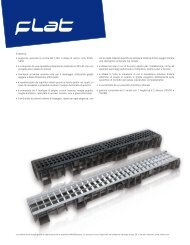MUFLEDRAIN TECHNICAL MANUAL - MUFLE.com
MUFLEDRAIN TECHNICAL MANUAL - MUFLE.com
MUFLEDRAIN TECHNICAL MANUAL - MUFLE.com
You also want an ePaper? Increase the reach of your titles
YUMPU automatically turns print PDFs into web optimized ePapers that Google loves.
ELEMENTS OF HYDROLOGY<br />
Processing pluviometric data<br />
CONCENTRATION TIME TC<br />
Clearly the volume of the water fl ow to be drained does not<br />
depend only on the precipitation but also on its duration. If the<br />
precipitation has height P and duration t (with average intensity<br />
P/t) and occurs over the entire draining area, the maximum<br />
volume is reached when contributions from all the parts making<br />
up the surface reach the runoff section.<br />
This time interval is defi ned as concentration time tcIt is simply<br />
the time that the most distant drop of water takes to reach the end<br />
of the drainage system.<br />
Based on this, when processing the pluviometric data, it is<br />
necessary to consider the precipitation according to concentration<br />
time in order to determine maximum capacity.<br />
For example, in drainage systems that serve relatively small<br />
surface areas, concentration time ranges from few minutes to<br />
dozens of minutes. Therefore brief and intense precipitations<br />
(showers of rain) should be analysed with maximum duration of<br />
1 hour.<br />
EQUATIONS OF PLUVIOMETRIC POSSIBILITY<br />
The processing of the pluviometric data supplied by a monitoring<br />
station consists in looking for the mathematical relationship<br />
between the height of precipitation P and its duration t:<br />
P = P (t)<br />
Obviously, from the statistical point of view, its reliability depends<br />
on the amount of data available. Consequently the observation<br />
period must be long enough. It is believed that an observation<br />
period not smaller than 30/35 years can provide valid statistical<br />
results, although in some case observations not older than 10<br />
years have to be used.<br />
The many observations available have made it possible to see<br />
that, as time passes, rainfall diminishes. So the relationship we<br />
are looking for is of exponential type and can be expressed as<br />
follows:<br />
P = a t n<br />
Technik<br />
Where P and t are usually expressed in mm and hours respectively.<br />
The parameters dimensionless n and a (mm•h -n ) are characteristic<br />
of a curve and can be determined from time to time as they<br />
depend on the pluviometric characteristics of the area where the<br />
monitoring station in located. The exponent n is obviously less<br />
than the unit.<br />
Such relationships are called pluviometric possibility equations.<br />
They defi ne curves on the Cartesian plane (P, t) known as<br />
pluviometric possibility indication curves.<br />
RETURN TIME TR AND PROBABILITY OF NOT EXCEEDING<br />
THE CONCERNED<br />
In order to determine the functional link between the precipitation<br />
height, its duration and the probable frequency with which such<br />
height can occur, the relationship be<strong>com</strong>es:<br />
P(Tr) = a(Tr) t n(Tr)<br />
Where Tr is the so-called return time, that is the time poeriod<br />
in which the meterological event will on average be equalled<br />
or exceeded; it more simply defi nes the probability that the<br />
considered event is not exceeded; this probability results from<br />
the Gumbel distribution.<br />
Generally speaking low values of return time (2 to10 years) are<br />
used to measure a drainage system for meteorological water.<br />
STATISTIC ANALYSIS OF THE PRECIPITATIONS<br />
It is supposed that the maximum brief and intense precipitation<br />
values recorded by a theoretical pluviometric station X for a<br />
certain number of years Y are available.<br />
By ordering this data, a table with a number of lines equal to the<br />
observation years Y and a number of columns equal to the lengths<br />
of observation (10,15, 30 and 45 minutes) is obtained.<br />
301





